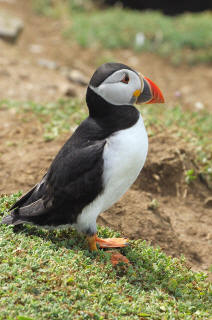Article
|
Puffin
Latin Name:
Fratercula arctica
The 'Clown of the Sea' or 'Sea Parrot' are other
affectionate names given to
the Puffin. The Puffin is the best-known of the British auks – its colourful and slightly
clown-like appearance making it immediately recognisable.
The Puffin’s short wings are used for ‘flying’ underwater in search of fish,
large wings would be a disadvantage but small wings make flying in air rather
more difficult and the birds must beat their wings rapidly to stay aloft. The
Puffin’s beak is only distinctively-coloured in summer; the large red and grey
scutes or horny plates together with the fleshy yellow rosette in the corner of
the mouth are grown late winter for use in display. After the breeding season
they are moulted, the winter bill is relatively small and constricted at the
base, and blackish in colour as is the face. |

Notice the Yellow Spot,
now put your mouse over the picture
 |
Identification
An unmistakable bird with its black back and white
front. Its black head with large pale cheeks which can be grey
to white, and its flattened, brightly-coloured orange triangular bill during the
breeding season. The orange bills are grown just before the breeding
season and shed afterwards. It also has red and black eye-markings and bright
orange legs. At breeding colonies they will make a deep growl noise, but are
silent when at sea.
|
Animal
Facts
In Britain: March-Mid August
Life Span: Average life expectancy around
25 years, although some on Skomer have been recorded as more than 38 years old!
Statistics: 28-34 cm in length with a 50-60cm wingspan. Male is slightly
larger than female.
Habitat: Breeding season around the coasts
of northern Europe. Winter months spent at sea.
Food: small fish such as sprats, herring
fry and especially Sand Eels. They can hold around 10 sand eels in their beak at
a time, although there have been reports of 62 fish in their beak at once.
|
Conservation
Status

Least Concern |
Both parents bring food to the chick, the commonest item is Sand
Eels which
the parents catch by diving. Having caught a Sand Eel, it is held between the
tongue and upper mandible, enabling the bird to catch another, and another. On
Skomer, the normal number of fish carried back to the nest at each visit is
about 10, but the world record is 80 (albeit small larval fish), recorded on an
island in northern Norway. Most chicks receive some five to eight feeds a day,
each averaging about eight grams.
 |
Breeding: Puffins are nesters, using
burrows on grassy cliffs, but they will also nest amongst rocks and scree. They
return to their nesting sites in April. Male puffins perform most of the
nest building in a burrow/chamber which may be
many feet underground and is often lined with bits of dead grass, Sea Campion
and Bluebell stems. The female lays her single egg, usually in
the early part of May. Eggs are incubated by the parent birds in turn for about six weeks. The
newly-hatched chick weighs about 35-45grams and is darkish-grey
in colour and the down is so long that it almost completely covers the small
bill and the legs and feet. The chick stays in the burrow for about six weeks and reaches a weight
of about 300 grams during this time.
Distribution:
Formerly much more common in southern Britain, there are now few Puffin
colonies south of the Scottish border and those of the Farne Islands in
Northumberland and Skokholm and Skomer in Pembrokeshire are
three of the most important. An
accurate census is difficult, but the best estimates indicate that there may
be about 2,000 breeding pairs on Skokholm and 6,000 on Skomer with 60,000
pairs on the Farne Islands. Largest colony
on St Kilda with an estimated 250,000 pairs.
|
Behaviour:
Towards the end of July, the chicks are ready to leave
the nesting site, they
are still not fully-grown, being about 70% of the adult’s weight. They can fly reasonably well at this stage.
However, they are still very vulnerable to attacks by predatory gulls, so leave at night, working their way down to the cliff-edge and taking off in the
darkness. They go by themselves and are out of sight of land by day-break.
Thereafter, they are on their own and receive no further parental care.
The young Puffin remains at sea for almost two years. From the age of two onwards the
young birds spend more and more time at the colony in summer, looking for a mate
and prospecting for a burrow. Although a few may start to breed at the age of
four, most do not do so until they are five. The breeding success of Puffins is
not very high, on average each pair rears a chick every two years and less than
one in five of these young survive to reach breeding age.
Once they have attained breeding age, they are
long-lived birds. In good times, as many as 95% of the breeding birds may
survive to breed the following year. A 95%
annual survival means that the average expectation of life for a Puffin that has
just started to breed is about 20 years, so that counting the five years of
immaturity, the average life expectancy of Puffins is about 25 years. Some birds
live much longer.
Best time to see them in large numbers is Mid June to Mid July, when they are
feeding their young, but also new arrivals are looking for new mates for next
year.
See Also
How
To Photograph Puffins

Where to Photograph Puffins

|